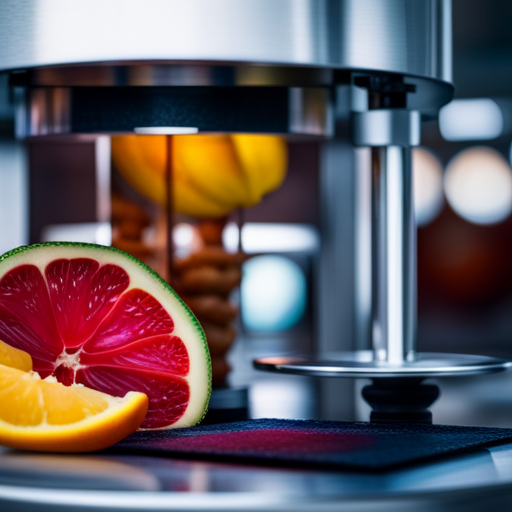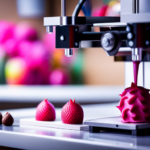Explore the symbiotic relationship between software and culinary artistry in the realm of food 3D printing.
Unveiling the intricate interplay of precision, customization, and innovation, this article delves into the pivotal role of software in revolutionizing the gastronomic landscape.
From enabling meticulous ingredient measurement to fostering unparalleled creativity, the integration of software in food 3D printing has redefined the possibilities of culinary craftsmanship.
Join us on a journey through the future implications and boundless potential of this groundbreaking fusion.
Design Software for Culinary Creativity
Design software for culinary creativity plays a pivotal role in enabling chefs to translate their artistic visions into tangible, 3D-printed culinary creations. This specialized software empowers chefs to engage in culinary design with unparalleled precision and creative customization. It allows them to experiment with intricate designs, textures, and structures that were previously impossible to achieve using traditional culinary techniques.
Through the use of design software, chefs can tailor every aspect of a dish, from its visual presentation to its texture and flavor delivery, to suit the specific preferences of their clientele. This level of creative control enables chefs to push the boundaries of traditional culinary artistry and offer unique, personalized dining experiences.
Moreover, the software facilitates the seamless integration of technology into culinary practices, allowing for the creation of innovative dishes that captivate not only the palate but also the visual senses.
Precision in Ingredient Measurement
When considering the precision in ingredient measurement for food 3D printing, it is essential to recognize the critical role that software plays in ensuring accurate and consistent dispensing of ingredients.
The precision of ingredient measurement is crucial in food 3D printing to achieve the desired taste, texture, and appearance of the final printed food product.
The following points highlight the significance of precision in ingredient measurement:
-
Accuracy in Measurements: Software enables the precise calibration of ingredient dispensing systems, ensuring that the exact amounts of each ingredient are measured and dispensed according to the specified recipe.
-
Consistency in Ingredient Dispensing: Through real-time monitoring and control, software helps maintain consistent ingredient dispensing throughout the printing process, minimizing variations in taste and texture.
-
Ingredient Consistency: Software facilitates the management of ingredient consistency by ensuring that the quality and properties of the ingredients remain uniform, contributing to the overall reliability of the 3D printed food products.
Customization and Personalization Capabilities
The precision and consistency enabled by software in managing ingredient measurement lay the foundation for the customization and personalization capabilities in food 3D printing. This technology allows for the creation of personalized recipes tailored to specific dietary needs and preferences. Through the use of advanced software, individuals can input their desired nutritional content, flavor profiles, and ingredient restrictions, resulting in the production of customized food items. Flavor customization is another key aspect facilitated by software, wherein individuals can adjust the taste, texture, and appearance of the printed food according to their preferences. This level of customization and personalization not only enhances the culinary experience but also caters to individuals with dietary restrictions or specific nutritional requirements. The following table illustrates the diverse customization and personalization capabilities offered by software in food 3D printing:
| Customization and Personalization Capabilities |
|---|
| Personalized Recipes |
| Tailored Nutritional Content |
| Flavor Customization |
| Ingredient Restriction Management |
| Texture and Appearance Adjustment |
This level of customization not only enhances the culinary experience but also caters to individuals with dietary restrictions or specific nutritional requirements. Transitioning into the subsequent section about ‘streamlining production processes’, these customization and personalization capabilities also contribute to efficient and targeted food production.
Streamlining Production Processes
Facilitated by advanced software, the streamlining of production processes in food 3D printing optimizes the efficient and targeted creation of customized food items, extending the capabilities established in the previous discussion on customization and personalization. This streamlining is achieved through:
-
Automated Production Scheduling: Advanced software allows for the seamless scheduling of production tasks, ensuring that the printing process runs continuously with minimal downtime, thereby improving efficiency.
-
Real-time Monitoring and Quality Control: Software-enabled monitoring systems keep track of the printing process, detecting and addressing any issues promptly. This ensures that the production of food items meets quality standards, reducing the likelihood of errors and minimizing material wastage, thus contributing to cost reduction.
-
Inventory Management and Supply Chain Optimization: Software facilitates the optimization of inventory levels and streamlines the supply chain, ensuring that the necessary raw materials are readily available. This prevents production delays and reduces excess inventory, resulting in improved efficiency and cost reduction.
Transitioning into the subsequent section about ‘enhancing culinary innovation with software’, these streamlined production processes lay the foundation for further advancements in food 3D printing.
Enhancing Culinary Innovation With Software
Building upon the streamlined production processes discussed earlier, software plays a pivotal role in enhancing culinary innovation in food 3D printing. By leveraging advanced algorithms and data analysis, software enables recipe optimization, empowering chefs to create intricate and customized culinary designs. This not only expands the possibilities within the realm of culinary art but also allows for greater precision and consistency in the final products.
In addition to recipe optimization, software facilitates flavor analysis, providing chefs with insights into the sensory aspects of their creations. This capability is integral to ensuring that the printed foods not only look appealing but also deliver on taste. Moreover, software aids in menu planning by offering tools for organizing and visualizing a wide array of 3D printable dishes, thereby fostering creativity and experimentation in the culinary domain.
The following table highlights the key ways in which software enhances culinary innovation in food 3D printing:
| Culinary Innovation With Software |
|---|
| Recipe Optimization |
| Flavor Analysis |
| Menu Planning |
Through these functionalities, software serves as a catalyst for pushing the boundaries of traditional culinary practices and driving new levels of creativity within the food 3D printing landscape.
Future Implications of Software in Food 3D Printing
An exploration of the future implications of software in food 3D printing reveals its potential to revolutionize culinary creation and dining experiences. This transformative technology has the capacity to bring about significant changes in the food industry, with far-reaching consequences for various aspects of society.
The future implications of software in food 3D printing can be understood through the following key points:
-
Ethical Considerations:
As food 3D printing advances, ethical considerations regarding the sourcing of ingredients and the production process will become increasingly important. Questions surrounding the ethical use of resources, fair labor practices, and the impact on traditional culinary practices will need to be addressed. -
Sustainability Impact:
The sustainability impact of food 3D printing software is a critical consideration. It presents an opportunity to minimize food waste, reduce the environmental footprint of food production, and explore alternative ingredients that are more sustainable to cultivate and consume. -
Culinary Innovation:
The role of software in food 3D printing will continue to drive culinary innovation, offering new possibilities for chefs and consumers alike. This technology has the potential to redefine the way food is prepared, presented, and experienced, leading to a new era of gastronomic exploration.
These future implications underscore the need for careful consideration of ethical and sustainability concerns as software in food 3D printing continues to evolve.
Frequently Asked Questions
Can Software for Food 3D Printing Accommodate Dietary Restrictions and Allergies?
Software for food 3D printing can accommodate dietary restrictions and allergies through customized recipes and ingredient substitution. These features enable personalized food production, catering to individual needs and ensuring safe and suitable consumption.
How Does Software Ensure the Safety and Sanitation of the 3D Printing Process for Food?
Ensuring the safety and sanitation of the 3D printing process for food is crucial. Software plays a vital role in this, providing safety assurance through precise temperature control and monitoring sanitation to uphold food safety standards.
Are There Software Solutions That Allow for Real-Time Adjustments to Recipes and Designs During the Printing Process?
Real-time adjustments to recipes and designs during the printing process are facilitated by specialized software solutions in food 3D printing. These software enable customizable recipes, allowing for dynamic modifications to be made during the printing process.
What Kind of Training or Expertise Is Needed to Effectively Use the Design Software for Culinary Creativity?
To effectively use design software for culinary creativity, individuals need training and expertise in 3D modeling, digital design, and culinary arts. This specialized knowledge enables them to harness the full potential of the software for innovative food creation.
How Does Software for Food 3D Printing Address Concerns About the Taste and Texture of Printed Food Products?
Software for food 3D printing rigorously addresses concerns about taste and texture through precise formulations, allowing for real-time adjustments. Beyond taste and texture, it also caters to user experience, dietary restrictions, and ensures safety and sanitation compliance.
Conclusion
In conclusion, the integration of software in food 3D printing acts as the artist’s brush, allowing for precise and intricate designs in culinary creations.
It serves as the architect’s blueprint, ensuring accuracy and efficiency in ingredient measurement.
The software opens the door to endless possibilities for customization and personalization, like a tailor sewing a bespoke garment.
As technology continues to advance, the implications of software in food 3D printing will undoubtedly shape the future of culinary innovation.


